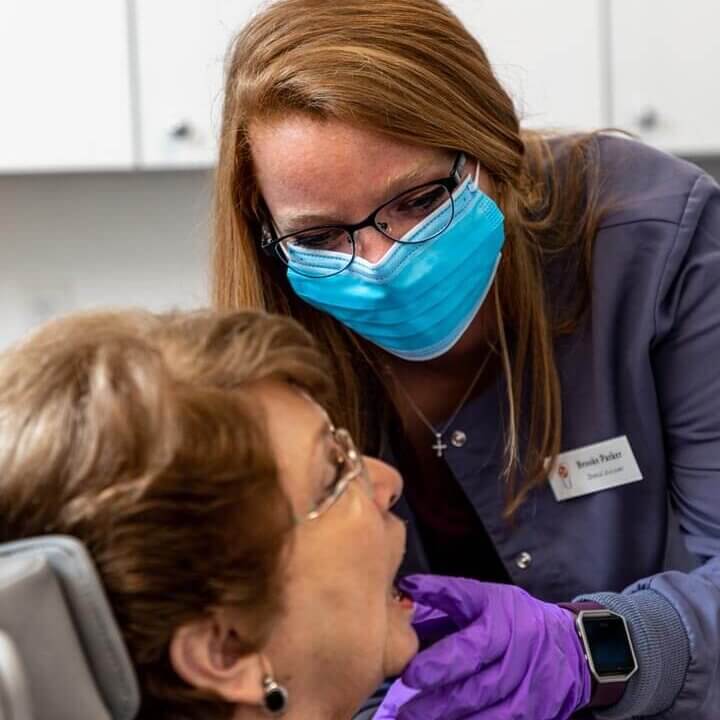Affordable Tooth Extractions

At Tennessee Valley Oral Surgery, we will take every chance to not remove your teeth, however sometimes it can be the only option to have a tooth extraction. If that is decided as the best course of action, we will certainly make sure you will be comfortable. With our latest technology, and our surgical experience, we will make sure you are comfortable and have a great outcome.
Why have a tooth extraction?
Generally, there are three usual reasons as to why a dentist would recommend a tooth extraction.
1. Infection – If you are unable to solve the problem with a root canal, and the serious infection in the tooth or gums is too advanced.
2. Braces – If you have an unwanted tooth and need to have braces for teeth alignment.
If you have severe tooth decay, and the tooth cannot be restored due to the damage.
Tooth Extractions: Simple or Surgical
Depending upon your tooth condition, the surgeon may have to get involved to develop a surgical plan. Simple extractions may be done by your dentist, but if it is a more complex procedure that needs to take place, we at Tennessee Valley Oral Surgery may need to be get involved. Our team is composed of highly skilled and professional oral surgeons and assistants to make your surgical plan comfortable and comprised of the highest standard of care.
Apicoectomy
While most root canals are successful, there are times when a root canal alone isn’t sufficient. If the infection from the dead nerve inside a tooth spreads beyond the tooth root and into the surrounding bone, your dentist may refer you to an oral and maxillofacial surgeon for an apicoectomy. During an apicoectomy, the oral surgeon removes the infected portion of the tooth’s root in order to clean the infection from the tooth and surrounding bone and then fills the root to prevent future infections.
Exposing Impacted Teeth (Expose and Bond) as Part of Orthodontic Treatment
It is not uncommon for teeth other than wisdom teeth to be impacted (or blocked) from entering the mouth. Fortunately, many of these teeth can be brought into proper position rather than removed. By working together, your oral and maxillofacial surgeon and orthodontist can often bring the impacted tooth through the gum and into the correct position through a procedure known as expose and bond. The OMS will expose the impacted tooth and bond an orthodontic bracket and chain to the tooth. This bracket will then be connected to the patient’s braces. The patient’s orthodontist or general dentist will then work to gradually bring the tooth into the proper position – resulting in a beautiful, healthy smile.
Frenectomy
Frena are small folds of tissue located in the mouth: under the tongue, inside the upper lip, inside the lower lip and connecting the cheeks to the gums.
A frenectomy is a simple procedure performed by an oral and maxillofacial surgeon to loosen the frenum’s connection and extend the range of motion.
Other Soft-tissue Oral Surgeries
Soft-tissue grafts in the mouth can be important to maintaining oral health. Soft-tissue grafts are used to add more tissue in a certain area and may be used to:
- Prevent further gum recession
- Cover an exposed root
- Stop sensitivity in the affected area
- Improve the look of the tooth
- Prevent issues in the future
Temporary Anchorage Devices (TADs)
Temporary anchorage devices (TADs) are occasionally used for a short time during orthodontic treatment. TADs are small titanium screws that orthodontists use to help reposition teeth.
TADs are usually placed by oral and maxillofacial surgeons in their office. When the TADs are no longer needed, they are removed and the site is usually fully healed in a couple days.
Gingivectomy and Gingivoplasty
Gingivitis, an inflammation of the gum tissue surrounding the teeth, is caused by bacteria that – if left unchecked – may lead to periodontitis. A gingivectomy surgically removes diseased or excess gum tissue and the bacteria that can cause periodontitis.
Gingivoplasty, which is the surgical reshaping of the gum tissue, is often performed in combination with a gingivectomy for functional or cosmetic purposes.
Crown-lengthening Procedures
Before placing a crown on a tooth that has been weakened by decay or is cracked, broken or severely worn down, your dentist may refer you to an oral and maxillofacial surgeon for a crown-lengthening procedure to ensure that enough of the tooth’s structure is available to securely hold a crown.
Call to Schedule Your Consultation Now
Schedule an appointment today. Don't worry, we'll take care of you like family.
